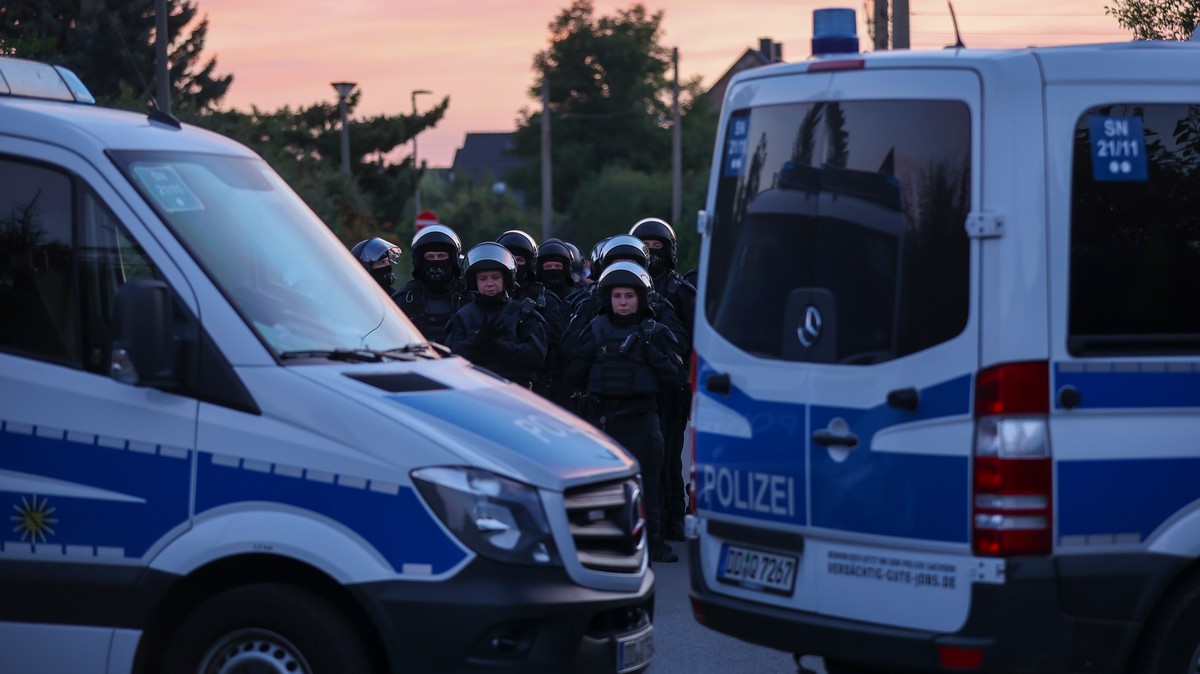Police officers secure a demonstration through the Grünau district of Leipzig. Photo: Jan Woitas/Picture Alliance via Getty Images
A spate of arson attacks is hitting refugee shelters in Germany, amid a wave of xenophobic violence fueled by anti-immigrant, pro-Kremlin sentiments within the far-right and conspiracy movements, experts say.
Experts say the attacks are reminiscent of the wave of violence that erupted after the so-called European migration crisis of 2015, when Germany’s decision to take in asylum seekers sparked a wave of attacks on refugees and their left-wing supporters. They say they fear the situation has the potential to escalate to the levels of violence that were there at the time almost 10 attacks on migrants every day in Germany in 2016 according to government figures.
“We fear that the situation from back then could repeat itself,” said Bruno Rössel, treasurer of the left-wing party Die Linke in Bautzen, a town of 40,000 in eastern Saxony where a hotel intended for refugees was the target of an arson attack on Friday .
“The fear is that there could be more violent attacks, people getting hurt.”
What is different this time is that the current wave of violence is being fueled in large part by far-right agitators stoking hostility towards Ukrainian refugees within the overlapping far-right and radical conspiracy theorist scenes, where strong pro-Kremlin sympathies exist. Experts say far-right groups are also toying with ordinary Germans’ struggles to pay their bills amid the energy crisis caused by Russia’s invasion of Ukraine to further stoke hostility towards Ukrainians and refugees in general.
“They play on ordinary people’s fears that they can’t pay their energy bills to fuel this sentiment,” Rössel told VICE World News.
The parallels to the previous wave of violence are so strong that the targets of the attack were sometimes hit beforehand. Friday’s attack on the Spreehotel in Bautzen, in which unknown assailants smashed windows and started a fire in the building where four sleeping employees were unharmed, was the second at that location in recent years.
The Spreehotel, which this week was due to take in the first of 200 refugees from countries including Syria, North Macedonia, Turkey and Afghanistan, was the target of an attempted arson attack back in December 2016 when it was housing 230 refugees. At the beginning of the year, in February 2016, another hotel in Bautzen, the Husarenhof, was used as refugee accommodation burned down in an arson attack when drunks stood cheering and clapping in front of the building.
“It’s impossible not to be reminded of the 2015 spate of violence against migrants,” Nicholas Potter, a right-wing extremism expert at the Amadeu Antonio Foundation in Berlin, told VICE World News.
He said the current surge in violence is the “most significant flare-up of attacks” since that time.
“It is no coincidence that the recent attacks took place in some of the same places where anti-refugee violence was prevalent in 2015 and 2016.”
In recent attacks, as in 2016, far-right parties and street protest movements have been accused of fueling tensions against migrants that have escalated into actual violence. On Tuesday, just three days before the attack in Bautzen, the far-right, anti-immigration party AfD (Alternative for Germany) demonstrated outside the hotel to protest the imminent arrival of asylum seekers and what they described as an “uncontrolled wave of migration.” According to Rössel, well-known neo-Nazis were present at the rally.
Saxony, the state of Bautzen, is a stronghold of the far-right party, which has been campaigning with a staunch anti-immigration program since 2015. The party denied any responsibility for the attack, saying it condemned violence and that the demonstration was an expression of the democratic right to protest.
But political opponents say they have some responsibility. “Anyone who spreads hate is complicit!” tweeted Silvio Lang, district chairman of the left in Bautzen, after the attack. Rössel said stoking dangerous fears of immigration has long been an integral part of the AfD’s modus operandi.
“I think that’s their job,” he said.
Alongside the AfD, the lateral thinking scene, the fleeting conspiracy-theoretic street movement that emerged during the anti-lockdown-and-vaccination pandemic and has sprung up ever since, has also been fueling radical anti-democratic and anti-migrant sentiment as significant threat to internal security.
Lateral thinkers demonstrate regularly throughout Germany; On Monday, three days after the arson attack in Bautzen, they held one of their regular marches through the city.
Rössel said that strong right-wing extremist elements, including well-known right-wing extremists, were regularly represented at the lateral thinking marches. Rössel said he sees the explosive, anti-democracy lateral thinking movement as a sort of continuation of the PEGIDA movement (Patriotic Europeans against the Islamization of the West) – the Islamophobic street protest movement founded in Saxony in 2014 that has played a key role in stoking xenophobic hatred during the migration crisis 2015. Online, lateral thinking activists are scathingly dubbed “QUERGIDA.”
While the xenophobic rhetoric of 2015-16 was heavily Islamophobic in character and railed against migration from the Muslim world, experts say the current climate has strong pro-Russian, anti-Ukrainian overtones – reflecting the open-minded audience among which the Kremlin propaganda had found right-wing extremist groups and conspiracy scenes worldwide.
Experts said agitators in the overlapping far-right and conspiracy scenes fueled pro-Kremlin sentiment within these groups, exploiting fears about the impact of the energy crisis on ordinary Germans to sharpen attitudes towards Ukrainian refugees. At a demo in Bautzen two days after the attack, demonstrators held an AfD banner that read: “If we freeze, the government must tremble.”
“Recent demonstrations in parts of East Germany are growing resentment over Russia’s war in Ukraine, where Ukraine, Germany or NATO and their allies are being blamed not only for the war but also for soaring domestic energy prices.” said Potter. “This anti-West, pro-Putin rhetoric is creating a hateful climate that now appears to be leading to very real violence against refugees not only from Ukraine but from other countries as well.”
The Bautzen incident was just one of many recent attacks. Unknown attackers on Monday night threw incendiary devices in a former school building to accommodate Ukrainian refugees in Neukieritzsch, Saxony. The attack, which caused no damage or injury, was the second time the building had been targeted, following a similar attack in 2015 after it was announced the building would be used as a refugee shelter.
The latest attacks came just weeks after a hostel for Ukrainian refugees was burned down in an arson attack in Groß Strömkendorf in northeastern Mecklenburg-Pomerania on October 19. The arson came just days after a swastika was scrawled on the building’s entrance.
Two months earlier, on August 19, a hostel for refugees was in the eastern German city of Leipzig target of an arson attack, resulting in minor property damage. Leipzig Mayor Burkhard Jung said it was no coincidence that the attack took place as Germany marked the 30th anniversary of a notorious xenophobic pogrom Several hundred neo-Nazis in the city of Rostock besieged a high-rise building housing Vietnamese migrant workers and Roma asylum seekers for several days.
Potter said the anti-Ukrainian nature of the recent attacks underscored the broad spectrum of far-right xenophobia.
“The recent attacks on refugee shelters designed to house Ukrainians show that the racists of the extreme right ultimately do not discriminate between different ‘types’ of refugees,” he said. “Anyone can become a target of their hateful ideology.”




